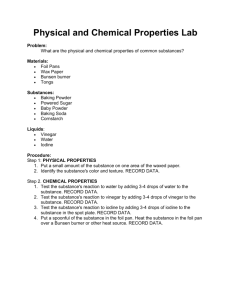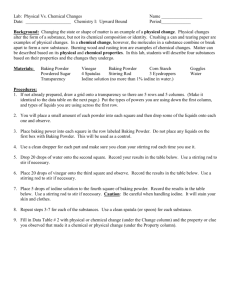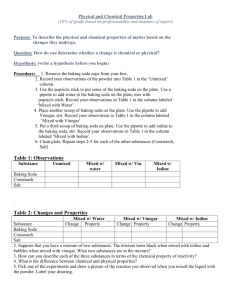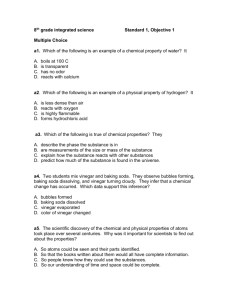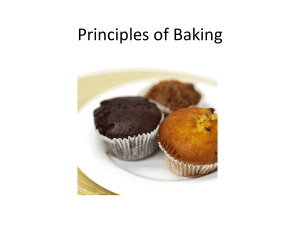substances reactivity
advertisement
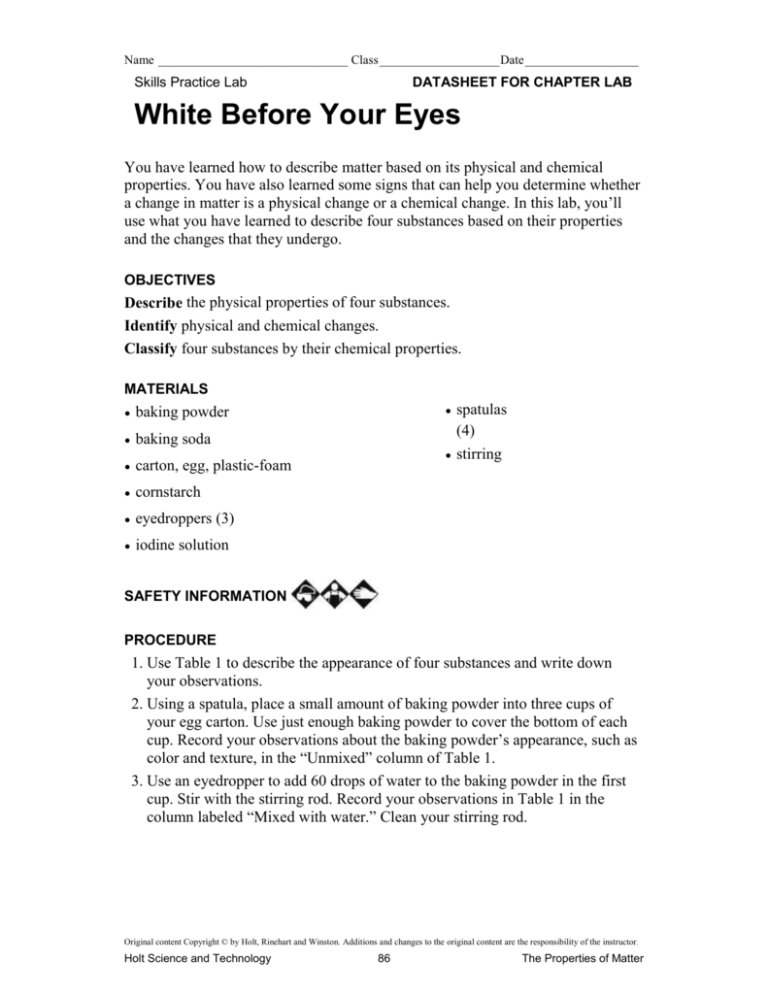
Name ______________________________ Class ___________________ Date __________________ Skills Practice Lab DATASHEET FOR CHAPTER LAB White Before Your Eyes You have learned how to describe matter based on its physical and chemical properties. You have also learned some signs that can help you determine whether a change in matter is a physical change or a chemical change. In this lab, you’ll use what you have learned to describe four substances based on their properties and the changes that they undergo. OBJECTIVES Describe the physical properties of four substances. Identify physical and chemical changes. Classify four substances by their chemical properties. MATERIALS • spatulas • baking powder (4) • baking soda • stirring • carton, egg, plastic-foam rod • cornstarch • sugar • eyedroppers (3) • vinegar • iodine solution • water SAFETY INFORMATION PROCEDURE 1. Use Table 1 to describe the appearance of four substances and write down your observations. 2. Using a spatula, place a small amount of baking powder into three cups of your egg carton. Use just enough baking powder to cover the bottom of each cup. Record your observations about the baking powder’s appearance, such as color and texture, in the “Unmixed” column of Table 1. 3. Use an eyedropper to add 60 drops of water to the baking powder in the first cup. Stir with the stirring rod. Record your observations in Table 1 in the column labeled “Mixed with water.” Clean your stirring rod. Original content Copyright © by Holt, Rinehart and Winston. Additions and changes to the original content are the responsibility of the instructor. Holt Science and Technology 86 The Properties of Matter Name ______________________________ Class ___________________ Date __________________ White Before Your Eyes continued Table 1: Observations Substance Unmixed Mixed with water Mixed with vinegar Mixed with iodine solution Baking powder Baking soda Cornstarch Sugar 4. Use a clean dropper to add 20 drops of vinegar to the second cup of baking powder. Stir. Record your observations in Table 1 in the column labeled “Mixed with vinegar.” Clean your stirring rod. 5. Use a clean dropper to add five drops of iodine solution to the third cup of baking powder. Stir. Record your observations in Table 1 in the column labeled “Mixed with iodine solution.” Clean your stirring rod. Caution: Be careful when using iodine. Iodine will stain your skin and clothes. 6. Repeat steps 2–5 for each of the other substances (baking soda, cornstarch, and sugar). Use a clean spatula for each substance. ANALYZE THE RESULTS 1. Examining Data What physical properties do all four substances share? _______________________________________________________________ 2. Analyzing Data In Table 2, write the type of change—physical or chemical— that you observed for each substance. State the property that the change demonstrates. Substance Table 2: Changes and Properties Mixed with water Mixed (vinegar) Baking soda Constrach physical Property reactivity with water solubility physical solubility physical reactivity with acid solubility Sugar physical solubility physical solubility Baking powder Change chemical Mixed (iodine solution) Change Property physical solubility Change chemical Property reactivity with acid chemical physical solubility chemical physical reactivity with iodine solubility DRAW CONCLUSIONS 3. Evaluating Results Classify the four substances by the chemical property of reactivity. For example, which substances are reactive with vinegar (acid)? _______________________________________________________________ _______________________________________________________________ _______________________________________________________________ Original content Copyright © by Holt, Rinehart and Winston. Additions and changes to the original content are the responsibility of the instructor. Holt Science and Technology 87 The Properties of Matter TEACHER RESOURCES Skills Practice Lab DATASHEET FOR CHAPTER LAB White Before Your Eyes Teacher Notes TIME REQUIRED One or two 45-minute class periods Joseph Price H.M. Browne Junior High Washington, D.C. LAB RATINGS Teacher Prep–2 Student Set-Up–1 Concept Level–2 Clean Up–2 MATERIALS Use an iodine solution that contains no more than 1.0% iodine in water. You may wish to use a 24-well spot plate or test tubes. A small test tube taped to the bottle makes a great holder for a dropper or pipette and decreases the chance of contamination. A drinking straw cut in half at an angle works well as a spatula; the pointed end is a great scoop, and its large size makes it easy to handle. SAFETY CAUTION When iodine is being used, be certain that a functioning eyewash is available. Caution students that iodine can stain skin and clothes. Students should wash their face and hands when finished. Clean up any spills immediately to avoid slips and falls. LAB NOTES Remind students that vinegar is an acid and that they should use caution when handling it. Although Table 2 shows that baking powder reacts with water, baking powder is not reactive with water. Baking powder can contain baking soda (a base), a weak acid, and a starch. The baking soda and the weak acid in baking powder will react with each other when the baking powder is dissolved in water. This reaction produces the bubbles that students observe in this experiment. DISPOSAL INFORMATION Dispose of any unreacted iodine solution by combining all students solutions. Decolorize if necessary by adding 1.0 M Na2S2O3 while stirring until the dark color disappears. Dilute the mixture with at least 10 times its volume of water before discarding. If local wastewater regulation permit, the diluted solution may be poured down the drain. Original content Copyright © by Holt, Rinehart and Winston. Additions and changes to the original content are the responsibility of the instructor. Holt Science and Technology 85 The Properties of Matter
